In the ever-evolving world of social media, staying fresh and relevant is key.
But how do you consistently come up with engaging social media content ideas?
This is a question that many marketers and business owners grapple with.
In this article, we aim to provide you with some inspiration.
We'll explore five innovative and actionable social media content ideas.
These ideas can be applied to your marketing strategies, whether you're focusing on B2B or general social media platforms.
Our goal is to inspire you to enhance your social media presence.
We want to help you engage with your audience more effectively.
And ultimately, we want to help you drive more traffic and conversions through creative content.
Whether you're a social media manager, a content marketer, a B2B marketing professional, or a small business owner, this article is for you.
Even if you're just someone looking to improve your social media content strategy, you'll find something useful here.
We'll delve into the importance of diverse content strategies.
We'll discuss the rise of video content, the power of user-generated content, and the effectiveness of interactive content.
We'll also touch on the role of educational content and the art of storytelling in your social media posts.
So, are you ready to take your social media content to the next level?
Let's dive in and explore these fresh social media content ideas.
1. Leveraging Video Content for Maximum Engagement
Video content is a powerful tool in the social media landscape.
It's a medium that allows for creativity, engagement, and storytelling.
But why exactly does video content reign supreme?
Let's delve into that.
Why Video Content Reigns Supreme
Video content is highly engaging.
It captures attention and encourages interaction.
In fact, social media posts with video have 48% more views.
This is according to HubSpot, a leading marketing platform.
Moreover, video content is versatile.
It can be used to educate, entertain, inspire, or promote.
It's a medium that caters to the increasingly short attention spans of social media users.
And it's a format that's favored by algorithms on many social media platforms.
Types of Video Content to Create
So, what types of video content can you create?
There are many options to choose from.
- Tutorial videos: These are great for educating your audience about your products or services.
- Behind-the-scenes videos: These can humanize your brand and build trust.
- Product reviews or demos: These can showcase the value of your offerings.
- Interviews or Q&A sessions: These can provide valuable insights and foster community.
- Live streams: These can create a sense of urgency and exclusivity.
Each type of video content serves a different purpose.
It's important to choose the right type based on your goals.
Tips for Producing Engaging Videos
Creating engaging videos requires some thought and planning.
Here are some tips to help you out:
- Know your audience: Understand their interests, needs, and pain points.
- Tell a story: Make your videos more compelling by weaving a narrative.
- Keep it short and sweet: Attention spans are short, so get to the point quickly.
- Use high-quality visuals: Crisp, clear visuals can make your videos more appealing.
- Include captions: Many people watch videos without sound, so captions are crucial.
Remember, the goal is to create videos that resonate with your audience.
And that encourage them to engage with your brand.
Measuring the Impact of Your Video Content
Once you've created and shared your video content, it's important to measure its impact.
This can help you understand what's working and what's not.
You can track metrics like views, shares, comments, and watch time.
These can give you insights into how your audience is interacting with your content.
You can then use these insights to refine your video content strategy.
Remember, the key to successful social media marketing is constant learning and adaptation.
2. Interactive Content: Polls, Quizzes, and More
Interactive content is a game-changer in social media marketing.
It's a type of content that requires active engagement from the audience.
This can be in the form of polls, quizzes, surveys, or contests.
But why is interactive content so powerful?
Let's find out.
The Power of Interactive Content
Interactive content is engaging.
It encourages users to participate and interact with your brand.
This can lead to higher engagement rates and more visibility for your posts.
Moreover, interactive content can provide valuable insights.
You can learn more about your audience's preferences, opinions, and behaviors.
This can inform your marketing strategy and help you create more targeted content.
Finally, interactive content can be fun.
It can make your brand more relatable and memorable.
Creating Compelling Polls and Quizzes
Creating compelling polls and quizzes requires some creativity and planning.
Here are some ideas to get you started:
- Product preference polls: Ask your audience to choose between two products.
- Opinion polls: Ask for your audience's opinion on a relevant topic.
- Trivia quizzes: Test your audience's knowledge about your industry or brand.
- Personality quizzes: These can be fun and shareable, increasing your brand's reach.
- Feedback surveys: Ask for your audience's feedback on your products or services.
Remember, the goal is to create polls and quizzes that are relevant and interesting to your audience.
And that provide value to both you and your audience.
Best Practices for Interactive Posts
Creating interactive posts is one thing.
Making them effective is another.
Here are some best practices to keep in mind:
- Keep it simple: Make your polls or quizzes easy to understand and participate in.
- Make it relevant: Ensure the topic is relevant to your audience and your brand.
- Offer incentives: Consider offering a reward to encourage participation.
- Promote your interactive content: Share it across your social media platforms to reach a wider audience.
Remember, the key is to create interactive content that resonates with your audience.
And that encourages them to engage with your brand.
Case Studies: Interactive Content Success Stories
Interactive content can be highly effective when done right.
Here are some success stories to inspire you:
- BuzzFeed's quizzes: BuzzFeed is known for its engaging and shareable quizzes. They have been a key driver of its social media engagement.
- Dove's "Real Beauty" campaign: Dove used polls to engage its audience and promote its "Real Beauty" campaign. The polls generated a lot of engagement and conversation.
These examples show the power of interactive content in driving engagement and conversation.
They demonstrate how interactive content can be used to promote a brand and its values.
3. User-Generated Content: Building Community and Trust
User-generated content (UGC) is a powerful tool in social media marketing.
It refers to any content created by users or customers, rather than the brand itself.
This can include reviews, testimonials, photos, videos, and more.
But why is UGC so effective?
Let's dive in.
Why User-Generated Content Works
UGC works because it's authentic.
It's created by real people, not marketers or advertisers.
This makes it more relatable and trustworthy to other users.
UGC also helps build a sense of community.
When users see their content featured on your social media, they feel valued and appreciated.
This can foster loyalty and encourage more UGC.
Finally, UGC can provide social proof.
Seeing other people use and enjoy your products can persuade potential customers to do the same.
How to Encourage and Curate User Content
Encouraging UGC requires a proactive approach.
Here are some strategies to consider:
- Create a branded hashtag: Encourage users to share their content with a unique hashtag.
- Host a contest or giveaway: Ask users to share a photo or video for a chance to win.
- Feature user content: Regularly share user content on your social media.
- Ask for reviews or testimonials: Encourage satisfied customers to share their experiences.
Remember, the key is to make your users feel valued and appreciated.
And to make it easy and rewarding for them to share their content.
Legal Considerations and Best Practices
While UGC can be highly beneficial, it's important to consider the legal aspects.
Always ask for permission before using someone else's content.
And give credit where credit is due.
It's also important to monitor the UGC you receive.
Ensure it aligns with your brand values and guidelines.
And that it's appropriate and respectful.
Examples of Successful User-Generated Content Campaigns
UGC can be a game-changer when done right.
Here are some examples to inspire you:
- GoPro's user-generated videos: GoPro regularly features user videos on its social media. This not only provides authentic content but also encourages more users to share their videos.
- Starbucks' #RedCupContest: Starbucks hosts an annual contest where users share photos of their holiday-themed red cups. The contest generates a lot of UGC and engagement each year.
These examples show the power of UGC in driving engagement and building community.
They demonstrate how UGC can be used to promote a brand and its products in an authentic and relatable way.
4. Educational Content: Positioning Your Brand as an Industry Leader
Educational content is a key part of any social media strategy.
It's about sharing knowledge and expertise with your audience.
But why is it so important?
And how can you create effective educational content?
Let's find out.
The Importance of Educational Content
Educational content can position your brand as an industry leader.
By sharing your knowledge, you show that you're an expert in your field.
This can build trust and credibility with your audience.
Educational content can also provide value to your audience.
It can help them solve problems, learn new skills, or understand complex topics.
This can increase engagement and foster loyalty.
Finally, educational content can help you stand out from the competition.
It shows that you're not just selling products, but also providing valuable information.
Types of Educational Content to Share
There are many types of educational content you can share on social media.
Here are some ideas:
- How-to guides: Teach your audience how to do something related to your industry or products.
- Webinars: Host live sessions to share knowledge and interact with your audience.
- Infographics: Use visuals to explain complex topics in a simple and engaging way.
- Case studies: Share real-life examples of how your products or services have helped customers.
Remember, the key is to provide value.
Your educational content should help your audience in some way.
And it should be relevant to your industry and brand.
How to Create and Share Knowledge Effectively
Creating educational content requires a deep understanding of your audience.
You need to know what they're interested in, what problems they have, and what they want to learn.
Here are some tips for creating effective educational content:
- Know your audience: Use social media analytics and customer feedback to understand your audience's needs and interests.
- Use visuals: Visuals can make complex topics easier to understand and more engaging.
- Keep it simple: Avoid jargon and complex language. Make your content easy to understand.
- Be consistent: Regularly share educational content to keep your audience engaged and coming back for more.
Remember, the goal is not just to share knowledge, but to do it in a way that's engaging and accessible.
Measuring the Effectiveness of Educational Content
How do you know if your educational content is effective?
You can look at engagement metrics like likes, shares, and comments.
But also consider qualitative feedback.
Are people finding your content helpful?
Are they learning something new?
This feedback can help you refine your educational content strategy.
And ensure you're providing real value to your audience.
5. Storytelling: Crafting a Compelling Narrative for Your Brand
Storytelling is a powerful tool in social media.
It can help you connect with your audience on a deeper level.
But how can you use storytelling effectively?
And what makes a good social media story?
Let's explore.
The Art of Storytelling in Social Media
Storytelling is about sharing a narrative.
It's about taking your audience on a journey.
A good story can evoke emotions.
It can make your audience feel something.
And this can create a strong connection between your audience and your brand.
Storytelling can also make your brand more memorable.
A good story can stick in your audience's mind.
And this can help your brand stand out in a crowded social media landscape.
Elements of a Good Social Media Story
A good social media story has several key elements.
Here are some things to consider:
- Characters: Who are the people in your story? They could be your employees, customers, or even your products.
- Conflict: What challenges or obstacles do the characters face? This can create tension and keep your audience engaged.
- Resolution: How do the characters overcome the challenges? This can provide a satisfying conclusion to your story.
- Message: What is the key takeaway from your story? This should align with your brand values and goals.
Remember, a good story is not just about what happens.
It's about how it makes your audience feel.
And it's about what it says about your brand.
Storytelling Strategies for Different Platforms
Different social media platforms require different storytelling strategies.
For example, Instagram is great for visual storytelling.
You can use photos and videos to tell your story.
And you can use captions to provide context and details.
On the other hand, Twitter is great for short, punchy stories.
You can use a series of tweets to tell a longer story.
And you can use hashtags to connect your story to larger conversations.
Here are some tips for storytelling on different platforms:
- Instagram: Use visuals and captions to tell your story. Use Instagram Stories for real-time storytelling.
- Twitter: Use a series of tweets to tell a longer story. Use hashtags to connect your story to larger conversations.
- Facebook: Use a mix of text, photos, and videos. Use Facebook Live for real-time storytelling.
- LinkedIn: Use professional stories to connect with a B2B audience. Use articles for longer, in-depth stories.
Remember, the key is to adapt your story to the platform.
And to use the unique features of each platform to enhance your story.
Examples of Brands Excelling at Social Media Storytelling
Many brands excel at social media storytelling.
For example, Airbnb often shares stories of hosts and guests.
This humanizes the brand and creates a sense of community.
Another example is Dove.
Their "Real Beauty" campaign shares stories of real women, challenging beauty standards.
This aligns with their brand values and resonates with their audience.
These examples show the power of storytelling in social media.
And they provide inspiration for your own storytelling efforts.
Implementing Your New Content Ideas
We've covered a lot of ground in this article.
From leveraging video content to crafting compelling narratives, we've explored a range of fresh social media content ideas.
Recap of Key Takeaways
Video content can significantly boost engagement.
Interactive content like polls and quizzes can foster a sense of community.
User-generated content can build trust and authenticity.
Educational content can position your brand as an industry leader.
And storytelling can create a deep connection with your audience.
Next Steps for Your Social Media Strategy
Now it's time to put these ideas into action.
Start by choosing one or two ideas that resonate with your brand.
Then, create a plan for how you'll implement these ideas in your social media strategy.
Remember, the key to successful social media content is consistency and authenticity.
So, keep your brand values in mind as you create your content.
And always strive to provide value to your audience.
With these fresh content ideas, you're well on your way to a more engaging and effective social media presence.
Additional Resources
We hope this article has given you a wealth of new ideas for your social media content.
But we understand that there's always more to learn.
Further Reading and Tools
To help you continue your journey, we've compiled a list of additional resources.
These include articles, guides, and tools that can further enhance your social media strategy.
- The Ultimate Guide to Social Media Marketing
- 10 Must-Have Social Media Tools for Small Businesses
- How to Create a Social Media Content Calendar: A Complete Guide
- The Science of Social Media: A Podcast by Buffer
- Social Media Analytics: The Ultimate Guide for Marketers
Remember, the key to success is continuous learning and adaptation. Happy posting!

















.jpg)




0 Comments